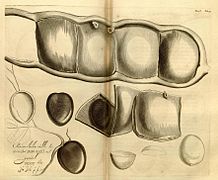Entada rheedii
| Entada rheedii | |
|---|---|

| |
| Pod at Talakona forest, in Chittoor District of Andhra Pradesh, India. | |
| Scientific classification | |
| Kingdom: | |
| (unranked): | |
| (unranked): | |
| (unranked): | |
| Order: | |
| Family: | |
| Genus: | |
| Species: | E. rheedii
|
| Binomial name | |
| Entada rheedii | |
| Synonyms | |
Entada rheedii, commonly known as the African Dream Herb or Snuff Box Sea Bean, and as the Cacoon Vine in Jamaica, is a large woody liana or climber. Their seeds have a thick and durable seed coat which allows them to survive lengthy periods of immersion in seawater.
Naming
Though the legitimate name was first published as E. rheedii, it is often written as Entada rheedei, honouring Hendrik Adriaan van Rheede tot Draakestein (1637–1691).[2]
Traditional use
The species is employed in African traditional medicine to induce vivid dreams, enabling communication with the spirit world. The inner meat of the seed would be either consumed directly, or the meat would be chopped, dried, mixed with other herbs like tobacco and smoked just before sleep to induce the desired dreams.[3]
The plant is also used as a topical ointment against jaundice, toothache, ulcers and to treat muscular-skeletal problems.[4] The seeds are sought after as pieces of jewelry and as good-luck charms.
Distribution
Its seeds are found on east and southern African beaches, having grown on river and estuary banks and in swamp forest. As a result of its ready dispersal by sea, Entada rheedii is widely distributed in tropical and subtropical countries, but strangely not the Americas. These include Kenya, Tanzania, Uganda, Cameroon, Equatorial Guinea, Gabon, Zaire, Ivory Coast, Ghana, Guinea, Guinea-Bissau, Liberia, Nigeria, Senegal, Sierra Leone, Togo, Malawi, Mozambique, Zimbabwe, KwaZulu-Natal, Bangladesh, Bhutan, India, Nepal, Sri Lanka, Cambodia, Laos, Myanmar, Thailand, Vietnam, Indonesia, Malaysia, Papua New Guinea, Philippines, Queensland.
References
- ^ "Entada rheedei information from NPGS/GRIN". www.ars-grin.gov. Retrieved 2008-03-10.
- ^ The International Plant Names Index (2004). Entada rheedei. Accessed 5 September 2007.
- ^ "Entada rheedii - African Dream Herb", www.entheology.org
- ^ "Indigenous use and bio-efficacy of medicinal plants in the Rasuwa District, Central Nepal". J Ethnobiol Ethnomed. 6: 3. 2010. doi:10.1186/1746-4269-6-3. PMC 2823594. PMID 20102631.
{{cite journal}}: CS1 maint: unflagged free DOI (link)
Gallery
- Entada rheedii




